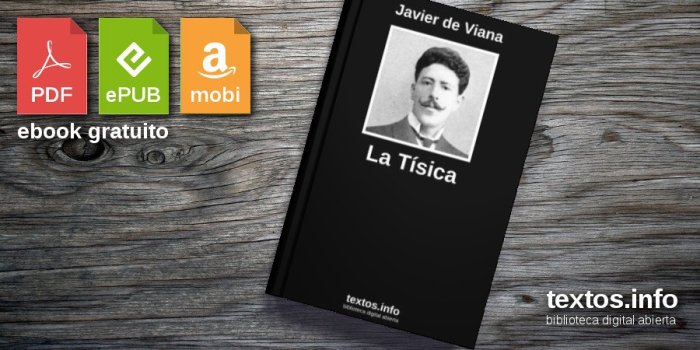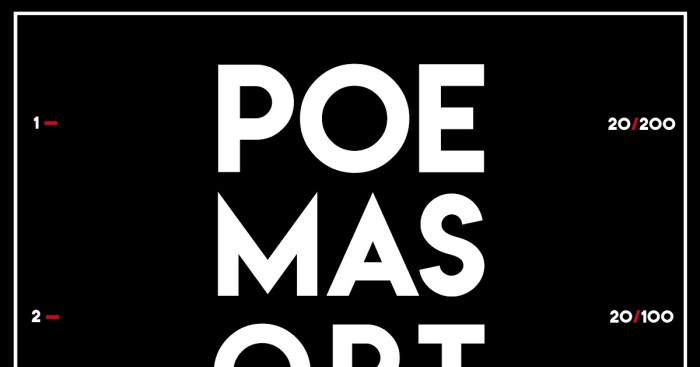La tísica javier de viana – Embark on a captivating literary journey with Javier de Viana’s masterpiece, La Tísica, a novel that delves into the depths of human struggle, societal norms, and the power of storytelling.
La Tísica transports us to the heart of Uruguayan society, where the protagonist’s poignant tale unfolds against a backdrop of historical and social complexities.
Literary Overview

Javier de Viana’s “La Tísica” is a renowned novel that encapsulates the Uruguayan literary landscape of the early 20th century. Set amidst the backdrop of Montevideo’s burgeoning society, the novel delves into the intricate lives of individuals grappling with the complexities of love, loss, and social change.
Written during a period of significant social transformation, “La Tísica” reflects the changing attitudes and values of Uruguayan society as it transitioned into a modern era. The novel’s exploration of themes such as class conflict, the role of women, and the impact of industrialization provides a valuable glimpse into the social and cultural dynamics of the time.
Main Themes
- Love and Loss:The novel centers around the poignant love story between Jorge and María, whose relationship is tragically cut short by María’s untimely death from tuberculosis.
- Class Conflict:The novel portrays the stark disparities between the wealthy elite and the working class, highlighting the social and economic inequalities that characterized Uruguayan society.
- The Role of Women:“La Tísica” explores the changing roles and expectations of women in a rapidly evolving society, challenging traditional gender norms and stereotypes.
- Impact of Industrialization:The novel depicts the profound effects of industrialization on the lives of individuals and the urban landscape, capturing the tensions between progress and social dislocation.
Characters
- Jorge:A young man from a wealthy family who falls deeply in love with María but struggles to reconcile his love with the social expectations placed upon him.
- María:A working-class woman who embodies the virtues of strength, resilience, and unwavering love despite her tragic fate.
- Doña Matilde:Jorge’s mother, a wealthy and influential woman who represents the conservative values of the upper class.
- Carlos:A friend of Jorge who provides a contrasting perspective on life and love, embodying a more bohemian and unconventional spirit.
Plot
The novel follows the lives of Jorge and María as they navigate the complexities of their forbidden love. Despite their strong bond, their relationship faces numerous obstacles, including Jorge’s family’s disapproval and María’s declining health. As María’s illness progresses, the couple grapples with the inevitability of her death and the profound impact it will have on their lives.
Character Analysis

La Tísica, the central character of Javier de Viana’s novel, is a complex and multifaceted individual. Her struggles with tuberculosis, her unrequited love, and her social isolation shape her personality and drive her actions.
Personality and Motivations
La Tísica is a young woman of great sensitivity and intelligence. She is deeply passionate about life and yearns for love and connection. However, her illness and her family’s poverty prevent her from fully realizing her dreams. Her frustrations and unfulfilled desires fuel her melancholy and self-pity.
Struggles
La Tísica’s primary struggle is her illness. Tuberculosis ravages her body and mind, leaving her weak and isolated. She longs for a cure but knows that her condition is terminal. This knowledge casts a shadow over her life, making it difficult for her to find joy or hope.
Relationships
La Tísica’s relationships with other characters in the novel are complex and often strained. She is deeply attached to her father, who is a kind and loving man. However, her relationship with her stepmother is distant and cold. La Tísica also has a close friendship with her cousin, Manuel, who provides her with emotional support and companionship.
La tísica javier de viana is a captivating tale of love, loss, and the complexities of the human heart. Similar to the protagonist in catcher in the rye flit , Javier de Viana grapples with the challenges of growing up and finding his place in the world.
Through his journey, he encounters both heartbreak and redemption, leaving readers with a profound understanding of the human experience. La tísica javier de viana is a timeless masterpiece that continues to resonate with readers today.
La Tísica’s most significant relationship is with her lover, Juan. Juan is a married man, and their affair is doomed from the start. La Tísica’s love for Juan is passionate and all-consuming, but it is also ultimately destructive. Juan’s betrayal and abandonment leave La Tísica heartbroken and disillusioned.
Symbolism and Imagery: La Tísica Javier De Viana

In “La Tísica,” Javier de Viana employs symbolism and imagery to evoke a vivid and emotionally resonant atmosphere. These elements contribute significantly to the novel’s themes of love, loss, and the fragility of life.
Imagery of Illness and Death
The novel is pervaded by imagery related to illness and death. The protagonist, María, is depicted as a victim of consumption, a terminal illness that slowly wastes away her body. This imagery serves as a poignant reminder of the fragility of life and the inevitability of death.
- María’s coughing is described as a “haunting melody,” evoking both her suffering and the beauty of her voice.
- The doctor’s stethoscope is portrayed as a “cold, metallic serpent,” symbolizing the relentless nature of her illness.
Symbolism of Nature
Viana also uses nature as a symbol throughout the novel. The changing seasons reflect María’s declining health, with the arrival of spring and summer symbolizing hope and renewal, while the onset of autumn and winter foreshadows her impending demise.
- The blooming flowers in the garden represent María’s youthful beauty and vitality, which gradually fade as her illness progresses.
- The wind and rain are used to symbolize the harshness of life and the inevitability of fate.
Symbolism of Objects
Objects also play a symbolic role in “La Tísica.” María’s piano, for example, represents her passion for music and her desire for a fulfilling life. The novel’s title, “La Tísica,” is itself a symbol of the protagonist’s doomed fate.
- The mirror reflects María’s changing appearance, highlighting the toll that her illness takes on her physical beauty.
- The crucifix symbolizes her religious faith, which provides her with comfort in the face of adversity.
Narrative Style
The narrative style in “La Tísica” is characterized by its lyrical and introspective nature, reflecting the protagonist’s inner turmoil and emotional struggles.
The novel employs a first-person perspective, with the protagonist serving as the narrator, providing a deeply personal and subjective account of her experiences.
Use of Literary Devices
The narrative is enriched by the skillful use of literary devices such as foreshadowing, irony, and stream of consciousness.
- Foreshadowing:Subtle hints and allusions are used to foreshadow future events, creating a sense of anticipation and suspense.
- Irony:The contrast between the protagonist’s hopes and the reality she faces creates a poignant sense of irony, highlighting the tragic nature of her situation.
- Stream of consciousness:The narrative often takes on a stream-of-consciousness style, capturing the protagonist’s unfiltered thoughts and emotions as they flow through her mind.
Impact on the Reader
The narrative style in “La Tísica” has a profound impact on the reader.
- The lyrical prose and introspective nature of the narrative draw the reader into the protagonist’s inner world, creating a deep sense of empathy.
- The use of literary devices, such as foreshadowing and irony, heightens the emotional impact of the story, making the protagonist’s struggles both relatable and heart-wrenching.
- The stream-of-consciousness style provides a raw and authentic glimpse into the protagonist’s mind, allowing the reader to witness her innermost thoughts and emotions.
Social and Cultural Impact

Upon its publication, “La Tísica” sparked a profound social and cultural impact in Uruguayan society. It challenged prevailing attitudes towards tuberculosis, shed light on the plight of the marginalized, and influenced subsequent works of literature and art.
Reflection of Society’s Attitudes
The novel’s depiction of the marginalized and the impoverished resonated deeply with Uruguayan society. It exposed the harsh realities of poverty, illness, and social inequality, prompting a reevaluation of societal values.
Influence on Literature and Art, La tísica javier de viana
“La Tísica” became a catalyst for the emergence of a new literary movement in Uruguay, known as “costumbrismo.” This movement focused on depicting the everyday lives and customs of ordinary people, particularly the marginalized.
The novel’s influence extended beyond literature. It inspired artists to explore similar themes in their work, leading to a greater awareness of social issues and a push for social change.
FAQ Guide
Who is Javier de Viana?
Javier de Viana was a renowned Uruguayan writer and journalist known for his evocative prose and insightful portrayal of Uruguayan society.
What is the main theme of La Tísica?
La Tísica explores the tragic consequences of social inequality, the struggle for identity, and the power of love amidst adversity.
How is symbolism used in La Tísica?
Viana employs symbolism throughout the novel to enhance its emotional depth, with imagery of disease, nature, and societal structures reflecting the characters’ inner struggles.